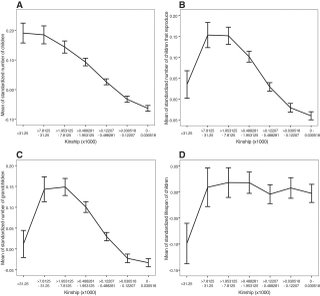
I'll admit it: I'm fully baffled by
the recent report by the cats at Decode that marriages between third and fourth cousins tend to be more fertile than other relationships. But it's a pretty fascinating observation--using their extensive Icelandic genealogies, they compile the figure on the right: on the x-axis is a measure of the relatedness of a couple, and the y-axis various measures of fertility. For the most relevant measures--the number of children that reproduce and the number of grandchildren--you see a sort of n-shaped curve, such that very closely-related and very distantly-related couples are less fertile than couples related at the level of third or fourth cousins.
Given the amount of data that they have, they're able to see this pattern is robust across historical periods, during which average relatedness of couples has decreased by an order of magnitude. And since Iceland is relatively socially homogeneous, the authors suggest there really is biology underlying this phenomenon. But how? I've no idea.
(See also
John Hawks).
Labels: Biology

